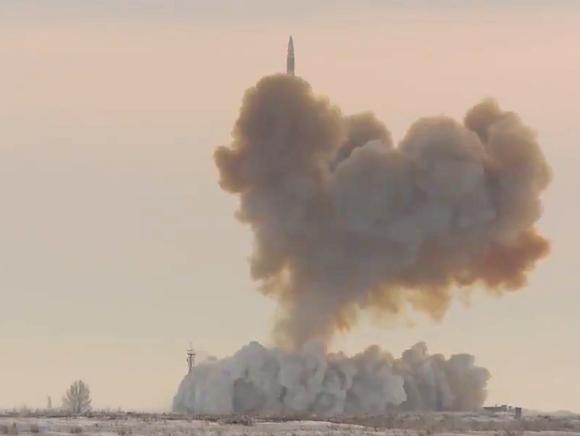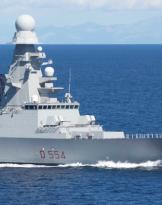During the conference on the state of the March 2018 federation, Russian President Vladimir Vladimirovich Putin took the opportunity to announce to the world the entry into service of a new class of conventional and strategic armaments destined to strengthen the Russian armed forces. In particular, the attention of most international observers was focused on six new so-called "strategic" weapon systems; among them, the one that has undoubtedly marked the greatest step forward, in terms of technological and doctrinal innovation, is the "planing supersonic vehicle Avangard".
Conceived as a means of strategic dissuasion with high technological potential, the Avangard represents the first "strategic weapon" of an entirely "Russian" conception. The rationale underlying this apparent oxymoron is that all the other strategic weapons currently in service with the Russian armed forces, as well as those that are being designed at the time, originate from the project work already begun in the Soviet era. On the contrary, it seems that Avangard is an absolutely new project and, in some ways, revolutionary. Often mis-described as a missile, in reality the Avangard is a glider that travels at supersonic speed. As can be inferred from the (poor) scientific literature on the subject, in case of operational use, the Avangard would be put into orbit by using the "launch vehicle" of a ballistic missile. In this regard, the Russian armed forces have specifically mentioned the UR-100NUTTKh / RS-18 (NATO code name: SS-19 Stiletto), the R-36M2 Voevoda (NATO code name: SS-18 Satan) and the RS-28 Sarmat (NATO code name: SS-X-30).
The Avangard would then be loaded into the launching head of a ballistic missile in place of the usual MIRV load (Multiple Independently targetable Reentry Vehicles) and subsequently released once the "booster" has reached its predetermined quota. At this point the glider would start to travel autonomously driven by a "scramjet" (Supersonic Combustion RAMJET - jet engine with very high performance) that, according to the Russians, should push the Avangard up to the speed of Mach 20-25 that, for a 40-50 ton vehicle, it's really a lot! At such speed, the glider would be enveloped by a "plasma" beam (the fourth state of matter) which would subject the vehicle to very high pressure and heat, at the same time shielding it from any type of known electromagnetic waves. This raises two important questions:
- What kind of materials do the Avangard structure cover?
- How did the Russians solve the problem of data transmission for route correction?
 If the first question can be answered by referring to the enormous progress made in recent years in the field of special ceramics for industrial use, the answer to the second question is not so obvious. To date, in fact, there is no physical theory that allows us to say that it is possible to send electromagnetic signals of any kind through a layer of plasma. This is the reason why space capsules and old ones Space Shuttle, at the time of re-entry into the atmosphere they were / are unable to communicate with the base for some time, until they came out of the atmospheric plasma field.
If the first question can be answered by referring to the enormous progress made in recent years in the field of special ceramics for industrial use, the answer to the second question is not so obvious. To date, in fact, there is no physical theory that allows us to say that it is possible to send electromagnetic signals of any kind through a layer of plasma. This is the reason why space capsules and old ones Space Shuttle, at the time of re-entry into the atmosphere they were / are unable to communicate with the base for some time, until they came out of the atmospheric plasma field.
If the Avangard behaves like a drone of the first generations, this problem would simply be solved by loading all the necessary data of the pre-established flight path in the on-board computer. However, both the senior summits of the Russian armed forces and President Putin himself have repeatedly emphasized the unique ability of Avangard to operate sudden and sudden changes of course at very high speed to avoid areas most covered by "domes" of anti-aircraft defenses and , to this end, the aerodynamics itself of the glider would have been treated in detail. Therefore, this capacity necessarily presupposes the presence of a driving system capable of receiving course corrections via satellite or other land, air or naval platforms. But how would such an operation be possible once the Avangard, at its maximum speed, is enveloped in a plasma beam? At the moment it is impossible, at least for the author of this article, to answer this question, but if the technicians of MITT (Institute of Thermal Technology Moscow) have really managed to break the "plasma barrier" then it would be one of the the biggest leaps forward in the field of physics, without any doubt worthy of the Nobel Prize.

The first field tests of the Avangard date back to February 2015 and continued until December 2018. On all these occasions, the glider has been repeatedly launched both by UR-100NUTTKh / RS-18 vectors and by R-36M2 Voevoda from the military polygon of Dombarovsky, in the Orenburg oblast, targeting targets located in the missile polygon of Kura, in the Kamchatka peninsula, in the Russian Far East. In one of these tests, in June of the 2016, the glider was pushed without problems up to the speed of 11.200 kilometers per hour (however much lower than the declared one of Mach 20-25) then successfully hit the "false target" designated.
The 26 December 2018, the Russians have made public a video of the last test of the Avangard after which, the glider can finally enter series production and, starting from the second half of the 2019, be delivered to the operational departments of the " Strategic Missile Forces "of the Russian Federation. Depending on the type of mission to be carried out (nuclear alert, precision attack, etc ...) Avangard can be equipped with both nuclear and conventional warheads, or it may be equipped with an inert head made of so-called "super-hard" materials in to act as a "kinetic weapon" against deep-lying targets, such as anti-atomic bunkers. In this case, to destroy the target would not be the power of the conventional or nuclear warhead used but the combination of gravity and kinetic energy freed from the falling body (the inert warhead) that would develop enough energy to free the ground in the seismic waves of a "small earthquake". In addition, the extreme precision of the weapon (again according to what was declared by the Russian authorities) and the possibility of being launched by three different ballistic missiles will also entail a considerable rationalization of military spending.
It remains to be seen how the glider will behave to the test of operational use and what types of countermeasures will be adopted by the Americans and their Western allies to nullify the threat. *
* NOTE: The Russian armed forces have made public the success of the last and final test of the Avangard 26 December 2018 by broadcasting a video. However, it is limited to showing the launch, by ballistic missile, from the Dombarovsky polygon. No Avangard image as such, as well as the glider's trajectory and "center" trajectory in the Kura range has been widespread. At the same time, news emerged from Eastern Siberia, from the Khabarovsk region, according to which a mountainous relief located on the bend of the river Bureya, a tributary of the river Amur, and far 73 kilometers from the nearest village (Chekunda) is literally "collapsed" "Inexplicably, literally collapsing on itself and pouring over the river below. To give the alarm were the technicians of a dam located in the area that, despite the considerable distance from the event area, recorded an anomalous "earthquake". The Russian authorities have not yet given an official explanation of the facts, even if the scientists questioned spoke of a massive landslide, or the fall of a very small meteorite. Probably there is no correlation between the Avangard test and the "Chekunda event" ... however, in the current state of affairs and in the absence of explanations, the coincidence of these two events could sound suspect.
(photo: MoD Russian Fed / web)












